Batch
Batches are used to distinguish the individual article deliveries or production batch.
Advantages of registration of batches consist of:
- the minimization of the article cards number (individual variants of an article are determined by batch characteristics),
- a detailed overview of the stock by individual characteristics of each individual delivery.
Batches book
You can always call the Batch book for a specific Article card: in the Article book with the Ctrl+F4 key, from document items by opening the Batch field, or from other places where there are fields with a link to batches. In this book there is list of batches relates to an appropriate Article card. Use the Ins key to create a new batch.
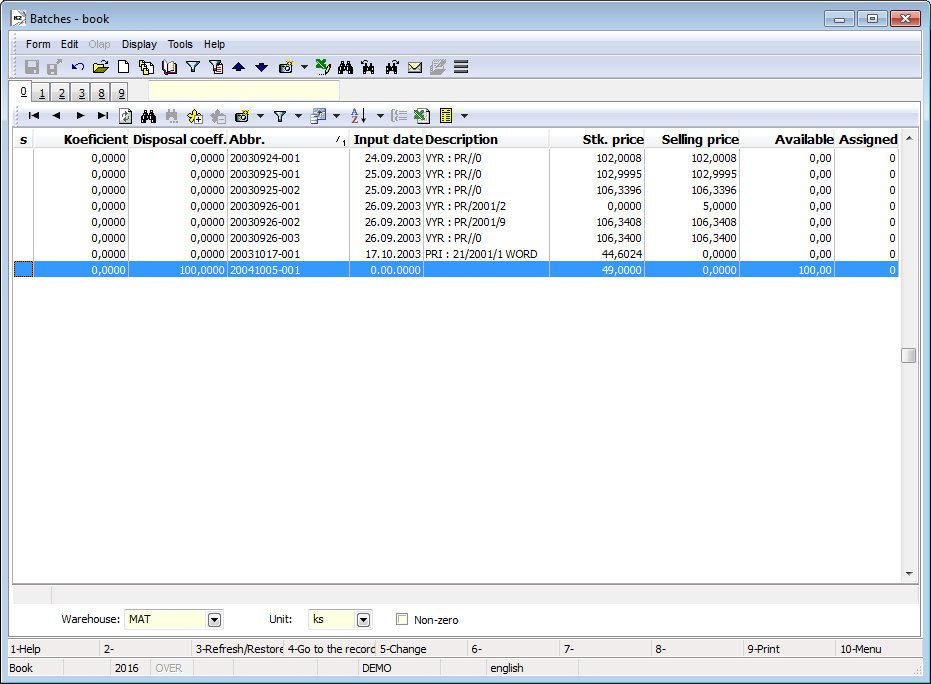
Picture: Batches book (display only batch with available)
Fields Description:
Information from the warehouse |
Warehouse from which Batch availability data is obtained. |
Non-zero |
By activating the option, only batches with a non-zero value of Available or Entered will be displayed in the list. |
Basic Data (1st page)
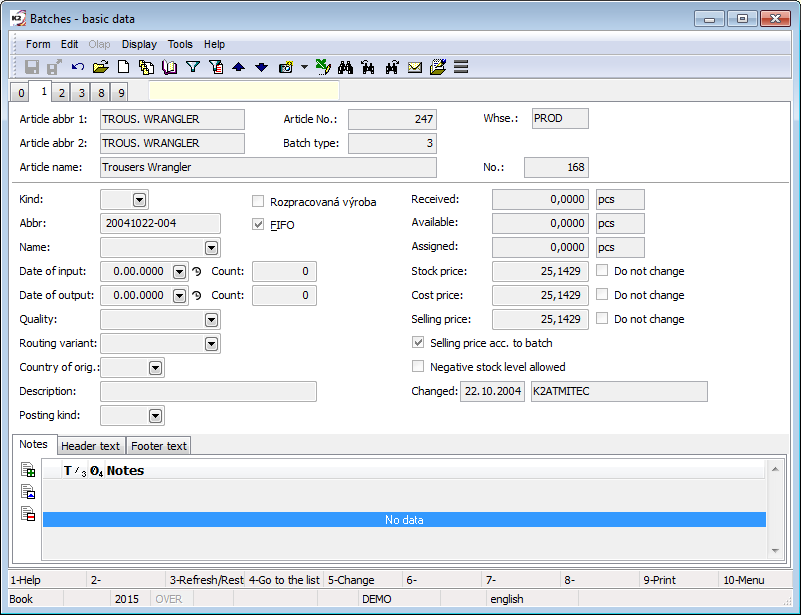
Picture: Batches - 1st page
Description of Fields:
Kind |
User code list - possibility to define the Batch type. |
Work in progress |
Indicates a batch produced by the removal of intermediate operations (the removal of the last operation). Note: ensures the correct sorting of batches on the 7th page of planning Job Cards. Furthermore, these batches are ignored to determine the price of the new batch at corrective receipts within inventories. |
FIFO |
An option whose activation specifies that the batch will be used when adding batches to releases by FIFO method. The FIFO field is checked by default when creating a new batch. A batch where the field is not checked will not be inserted in the document items, that means it will not be taken out. K2 evaluates the order of batches for releasing according to the FIFO method based on the batch abbreviation, see the description of the Abbreviation field. |
Abbreviation |
Batch abbreviation. In the K2 standard, the abbreviation consists of the date of batch creation and the serial number within the date. If three positions at the end of the batch abbreviation are used to determine the order (e.g. 20150625-999), then the order of the batches is indicated by adding the letters A to Z before this three-digit code (e.g. 20150625-A001) The batch abbreviation is decisive for FIFO removal. |
Name |
Batch name. |
Date of input |
Date of acceptance of the batch in the stock records. |
Date of output |
Field for entering the expiration date of the batch. |
Number |
The number of days (such as shelf life). |
Quality |
User code list - possibility to define batch quality. |
Routing variant |
Routing variant If the batch is created at production completion of a new product, a routing variant of a Completion Job Card is saved. |
Co. of origin |
Country of origin of an article. |
Description |
Description of a batch, e. g. receipt card number. |
Posting kind |
Posting kind - if specified on the Batch, it takes precedence over the Posting kind on the Article card. |
Received |
Data of the Article quantity in the "Received" status (after the first confirmation of receipt in case of double confirmation). |
Available |
Information on the availability of the Batch in stock. |
Assigned |
Information of the Article quantity in the "Assigned" status (unconfirmed release). |
Stock price |
Batch stock price. Batches are valued only in the case of receipt at the warehouse where the stocks are valued at "batch price". Batches will be valued at the first Receipt price. If the Receipt per Batch is made on several items within one document, then the Batch is valued at the average price of the given items. |
Cost price |
Batch cost price. In the K2 standard, it is identical to the Batch stock price. |
Selling price |
Batch Selling price. In the standard, it is automatically pre-filled with the Batch stock price. In the case of Sales prices by batch, this price is adjusted on the sales documents by a surcharge defined in the Sales prices of the Articles (relative sales price). |
Do not change |
A choice for stock, cost and sales price. If the option is activated for the relevant price, then the specified price is considered manually defined and is not recalculated on the basis of documents. |
Selling price acc. to batch |
If the Batch records option is activated on the 1st page of the Articles tab and at the same time the Selling Price by Batch option is activated on the 2nd page, then you can ensure that the created batches will have this option preset and the final selling price of the articles will be then according to the batch (edited by price and product groups). |
Negative stock level allowed |
Enables a negative batch status in stock. |
Changed by |
The date and name of the user who made the last change. |
On the 1st page of the Batch book, you can work with Notes in the Browse mode, using the Notes, Header Text and Footer Text tabs.
Batch Parameters (2nd page)
The list of defined parameters with the appropriate values for an individual batch is displayed on the 2nd page of batch card.
By Alt+H key you can display the history of individual parameter values.
Parameters can be changed only if the Change batch parameters user right is set (see Code lists/Batches/Change batch parameters).
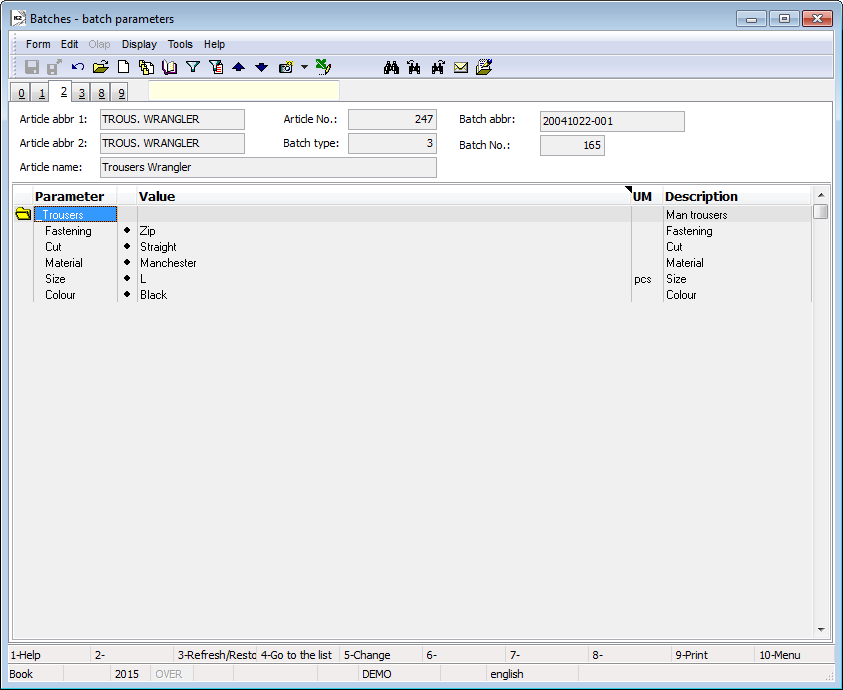
Picture: Batch - 2nd page

Picture: History of batch parameter values
Price by types (3rd page)
If it is a product or semi-finished product, then this 3rd page is used for the division of the batch price according to the Article types, which form the batch price according to the calculation formula. The decomposition is counted by the Stock recalculation function. It will count a planned, a stock and a cost price of a batch according to the appropriate costing models from a job card. You have to activate the Batch price acc. article categories option on the 2nd page of the Client parameters for counting of a batch price according to the items of a costing model.
Note: If the batch has the Do not change option activated for the stock or cost price, the division by types will not be performed for the given price and only the type of processed article card in the value of this manually entered price will be displayed in the division.

Picture: The Batches book - the 3rd page Price by categories
Stock card (8th page)
This page provides an overview of the stock movements of the batch for the selected period and stock. The controls and functions are identical to the Article stock card, the description is given in the chapter Basic code lists and support modules K2 / Articles / Article card / Stock card.

Picture: Batch - Stock card 8th page
External documents (9th page)
On 9th page of batch you can assign ext. documents or documents to an appropriate batch as in other modules. Further description of work with external documents is stated in the chapter Basic Code Lists and Supporting Modules K2 – 9th pagege.
Requested batch parameters
You can enter the required batch parameters on the Sales Item or Purchase Item, or at other K2 locations (Transfer Note item, Job Cards etc.). The field for entering the required parameters is available only if the articles have a batch record and at least one parameter is defined on the "P" page with the option activated. The value is defined on the batch or required parameters (internally there is a Batch Type for the card).
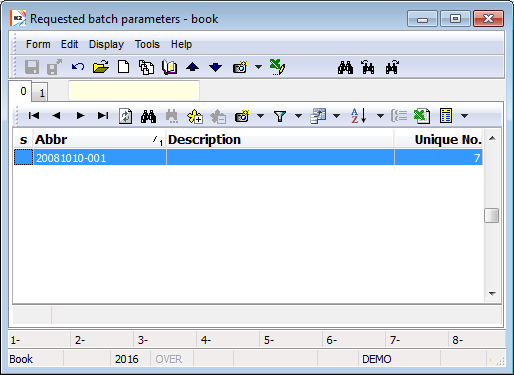
Picture: The Required batch parameters form - book
You can create a new record of the required parameters (header) with the Insert key, or a copy of the existing record with the F6 key. On the 1st page of the parameter list, after creating the record (header), those parameters from the Articles tab that have the Default required parameter option activated are automatically loaded. Other parameters can be add by pressing Ins key. In the editable "Value" column, you can enter their values for the parameters.
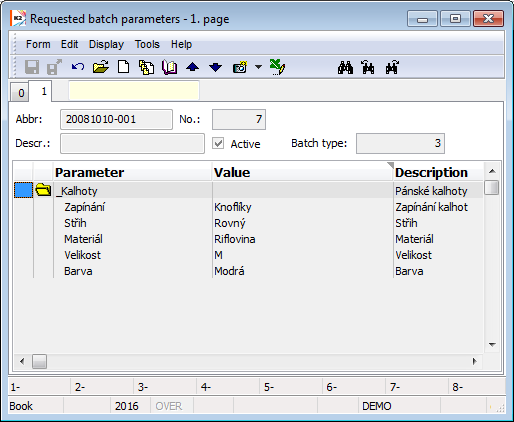
Picture: The Required batch characteristics form - 1st page
Required batch characteristics in production
The required batch parameters in production can be preset already in the routing variant of the product / semi-finished product (1st page, field Required par.). The required batch parameters can be entered only if the Article have a batch record and at least one parameter with the option activated on the "P" page. The value is defined on the batch or required parameters (internally there is a Batch Type for the card).
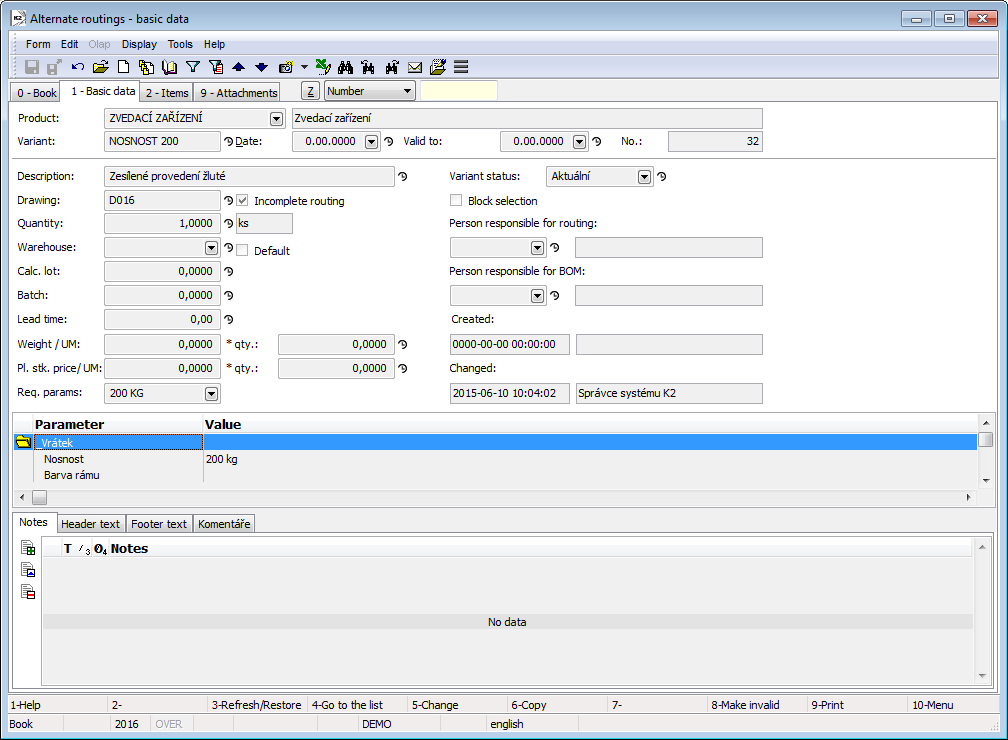
Picture: The definition of the required characteristics in Routing variant
The parameters entered in this way are then pre-offered when creating a Job Card on the 1st page of the Job Card in the Required par. On the Req. parameters tab, the individual parameters with the value are listed.
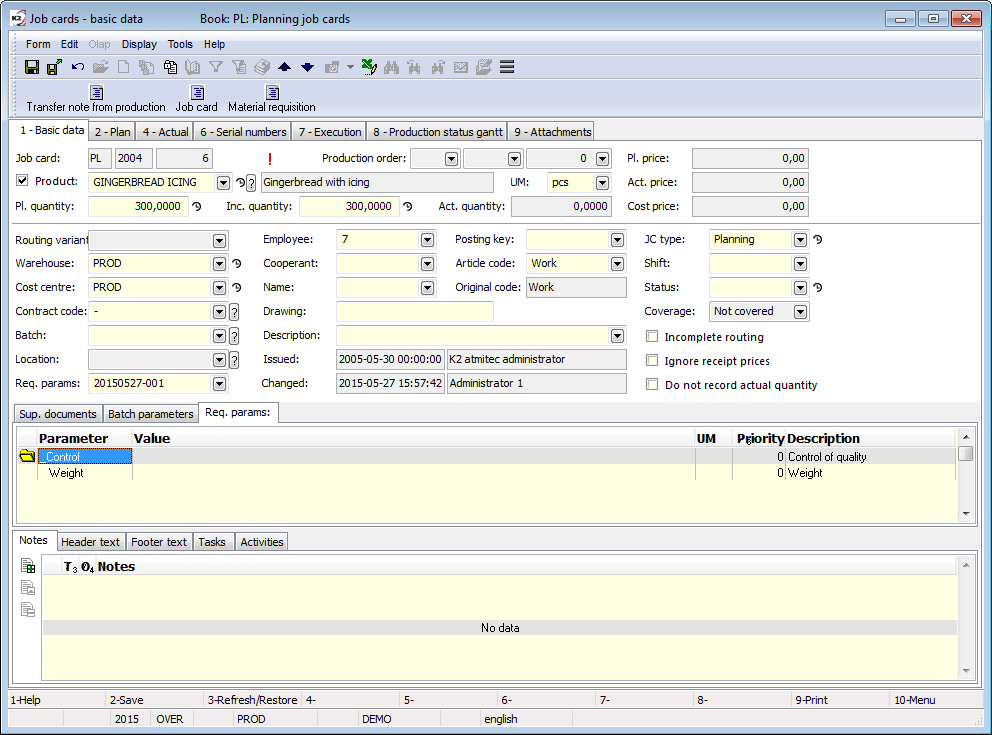
Picture: The Required parameters tab - Job card
Functions for batches over Article database
Description of functions:
Ctrl+F4 |
Switch to Batch book. |
Shift+Ctrl+F4 |
Filter Batch parameters of selected Articles. |
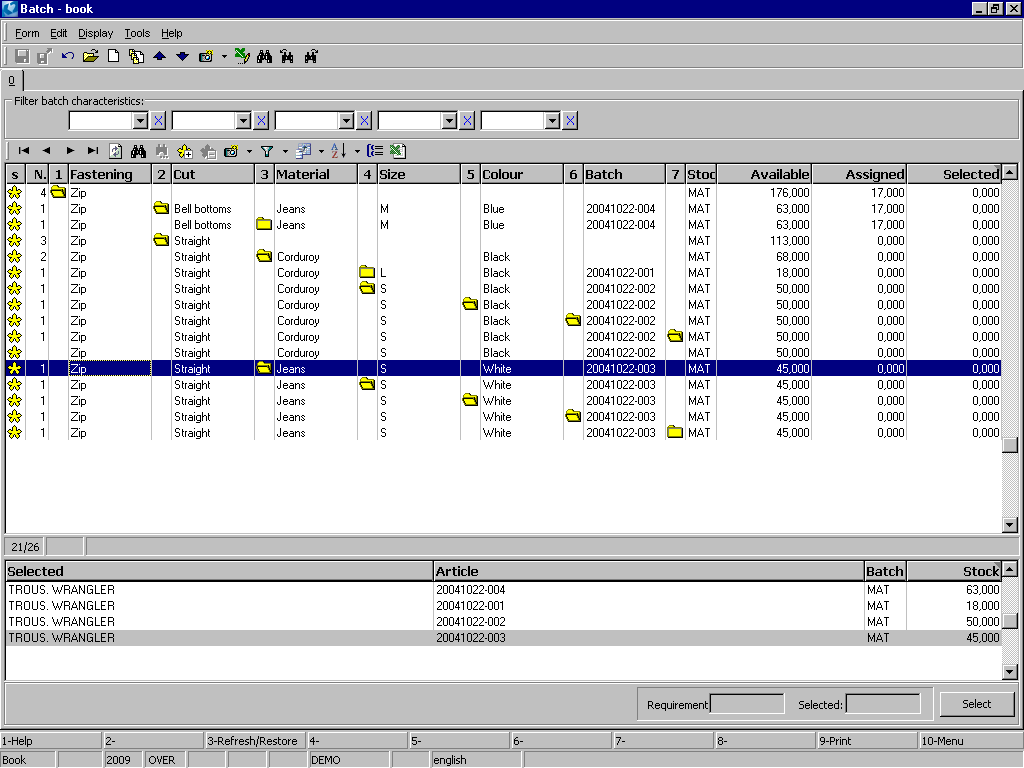
Picture: Batch parameters of Articles
Shift+Alt+F4 |
Filter the parameters of individual classifications. |
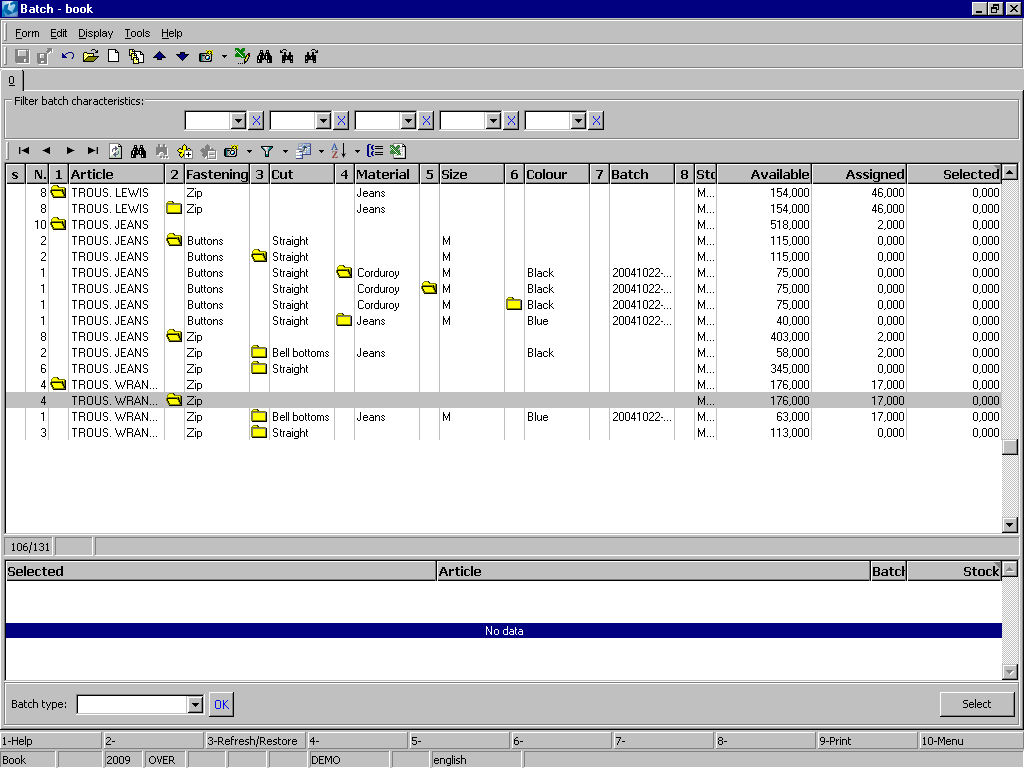
Picture: Batch parameters of classification
Shift+Ctrl+Alt+F4 |
Search for Articles (batches) according to batch parameters over the entire Article database. |

Picture: Batch parameters over all Articles database
In the left part, you can select parameters (by activating the Include parameter option or by assigning an asterisk using Ctrl+Spacebar) and the values of the given parameter (by assigning / removing asterisks for individual values using Ctrl+Spacebar). You should activate the Filter by values option to filter by settings. Filtering by the Use conditions button.